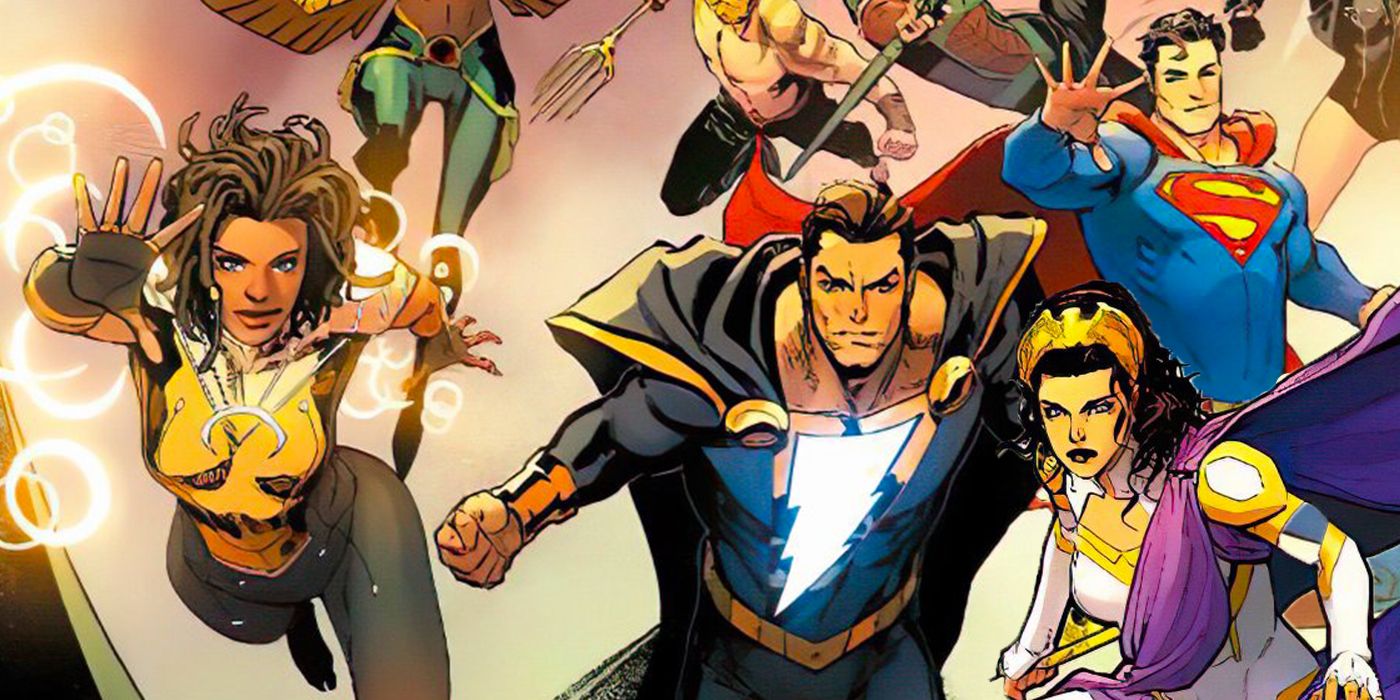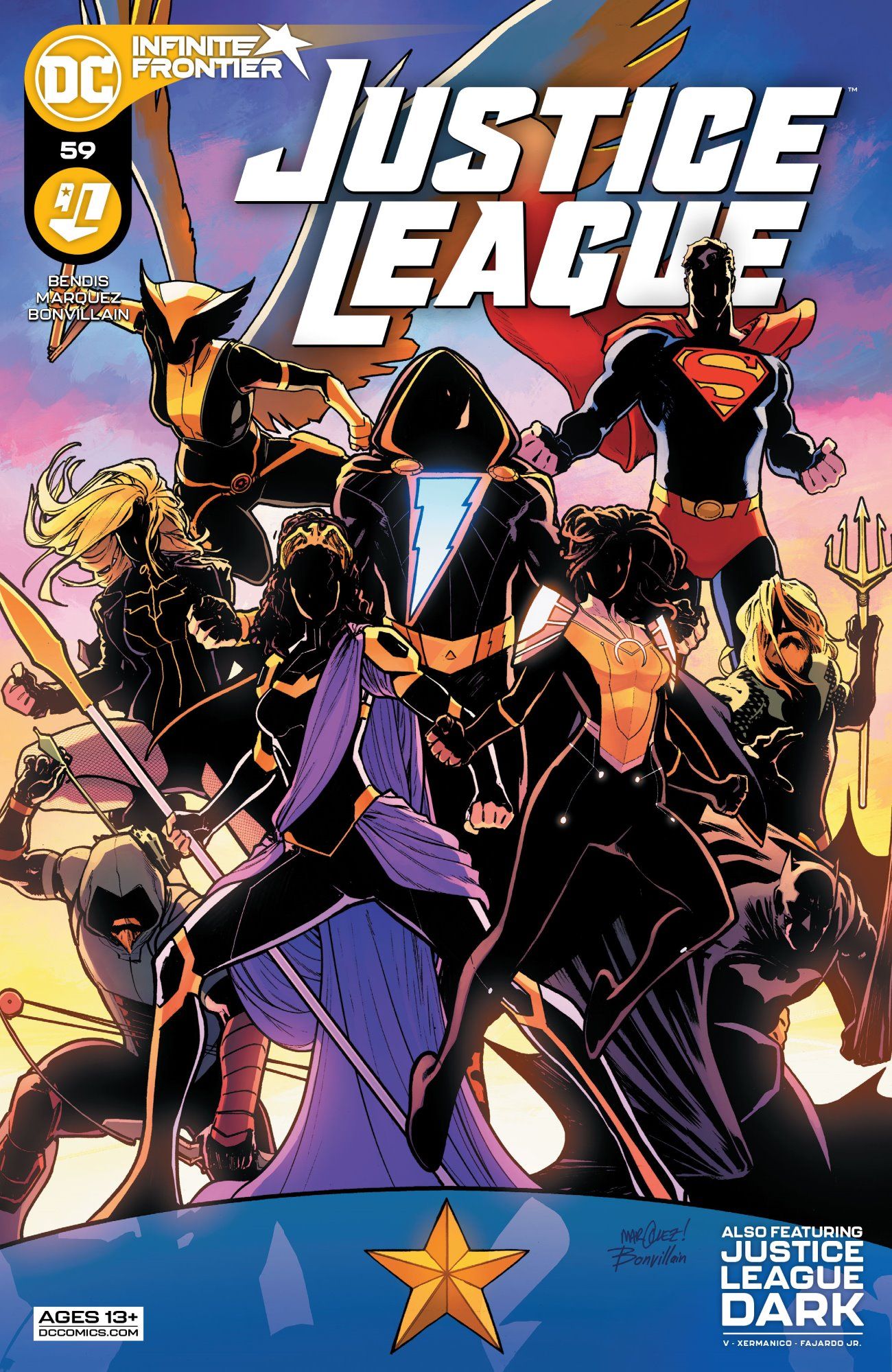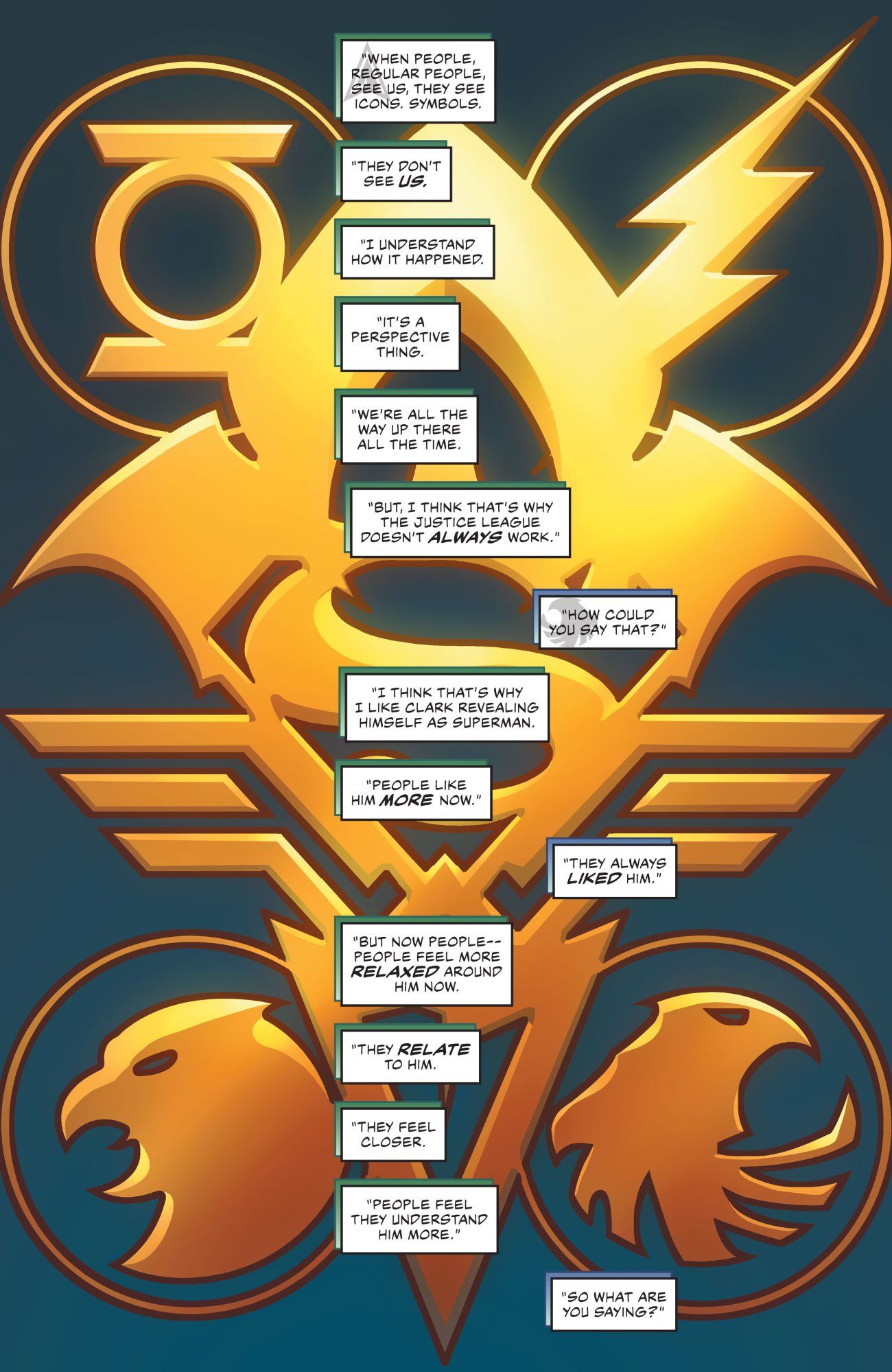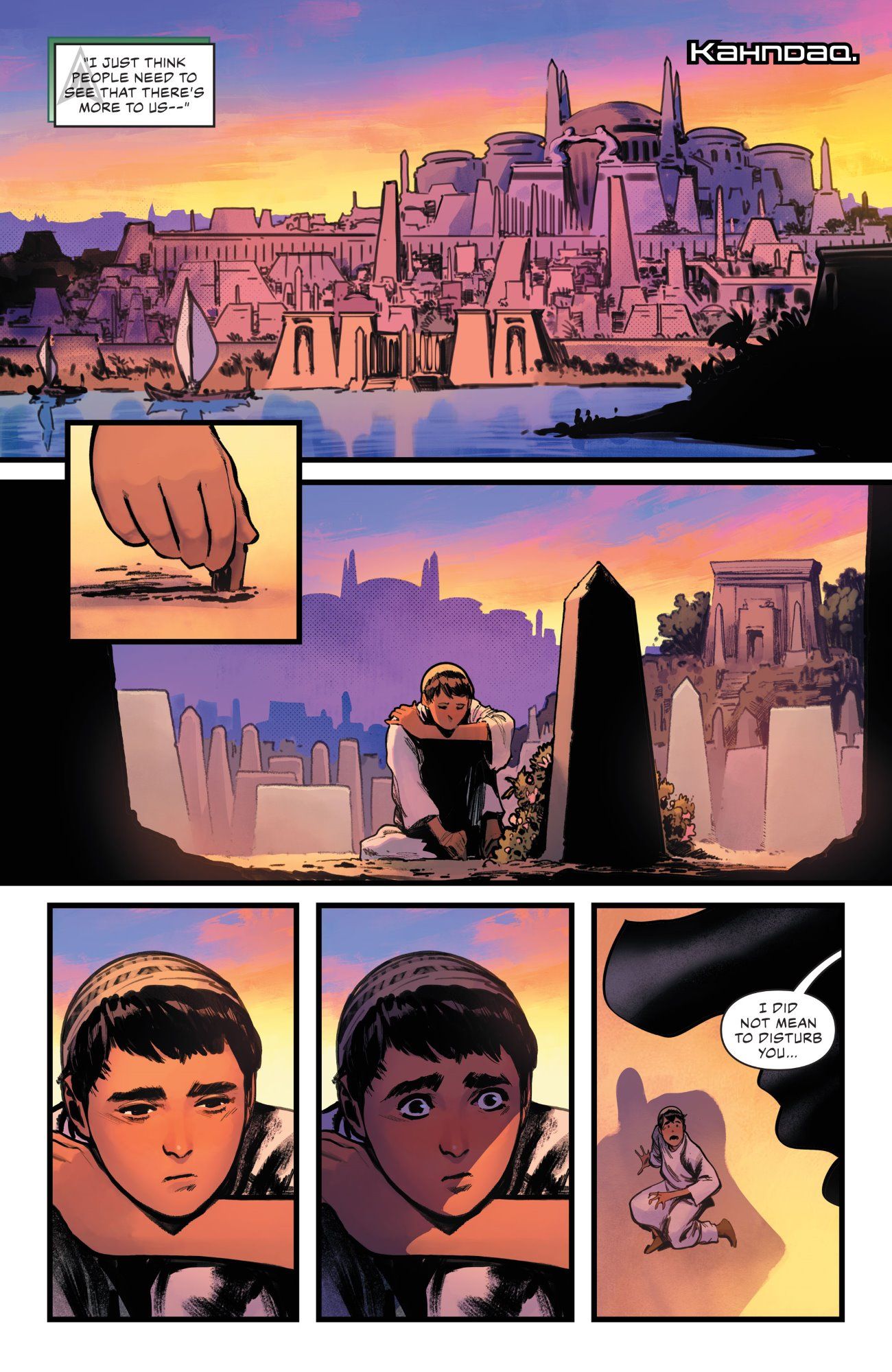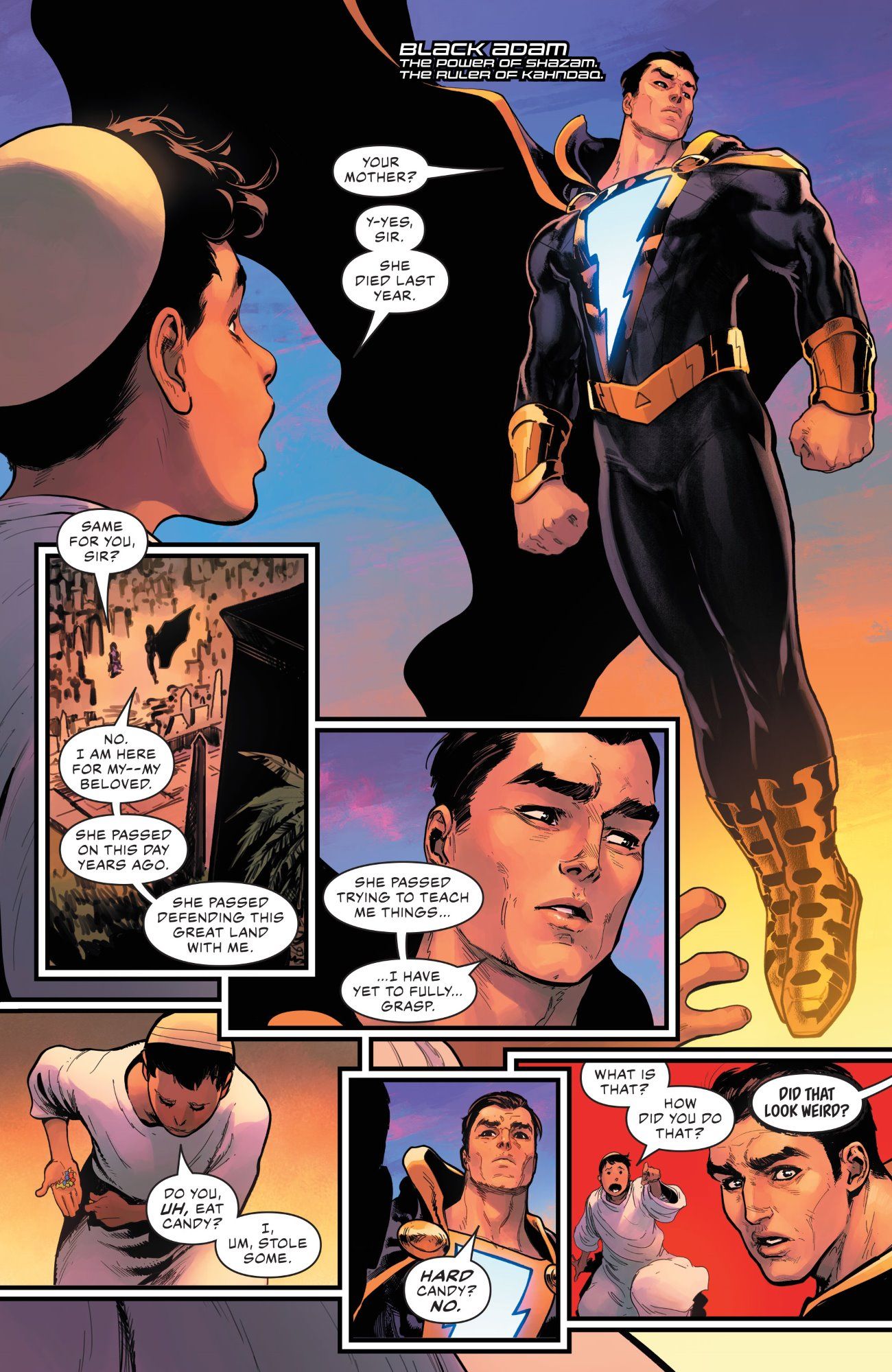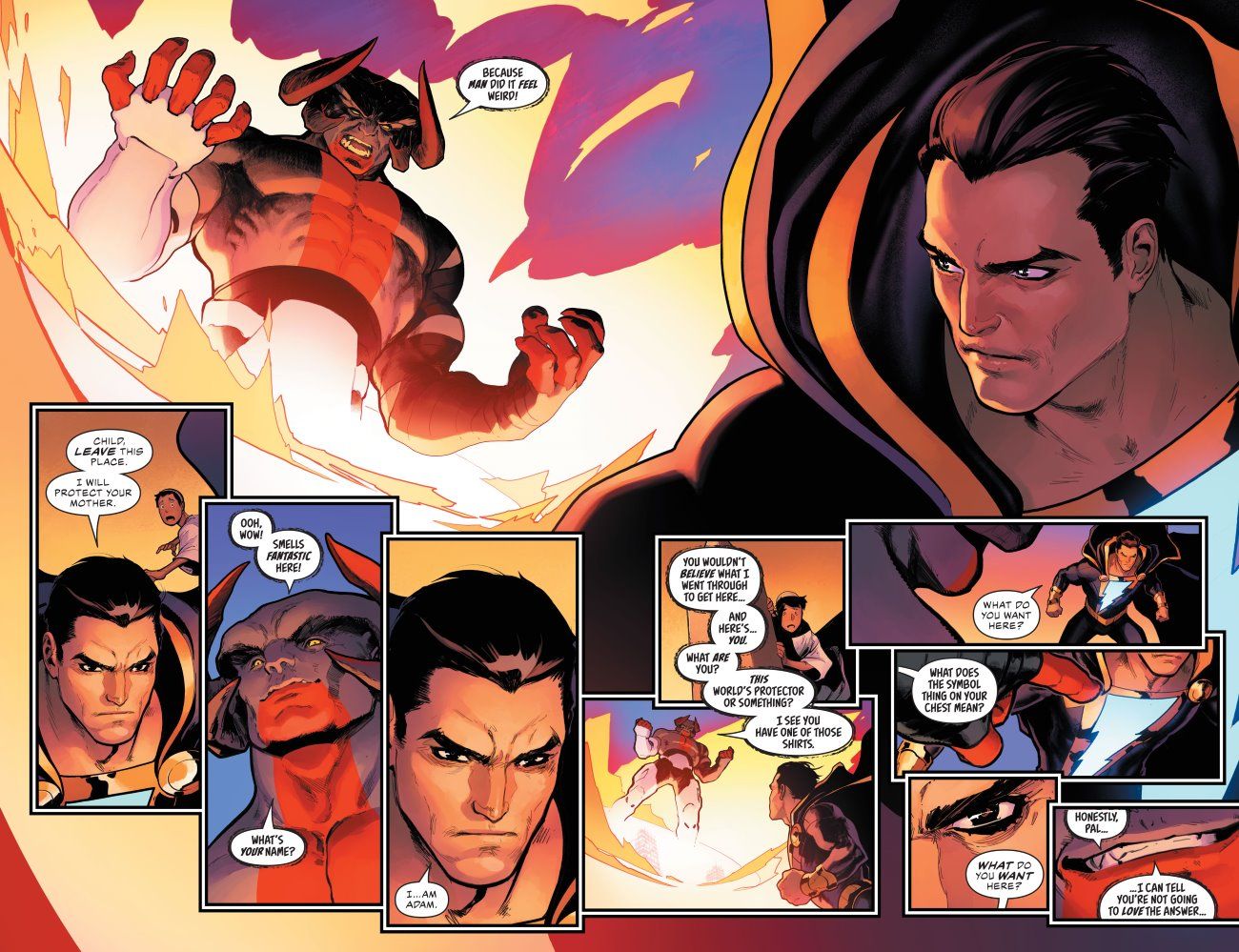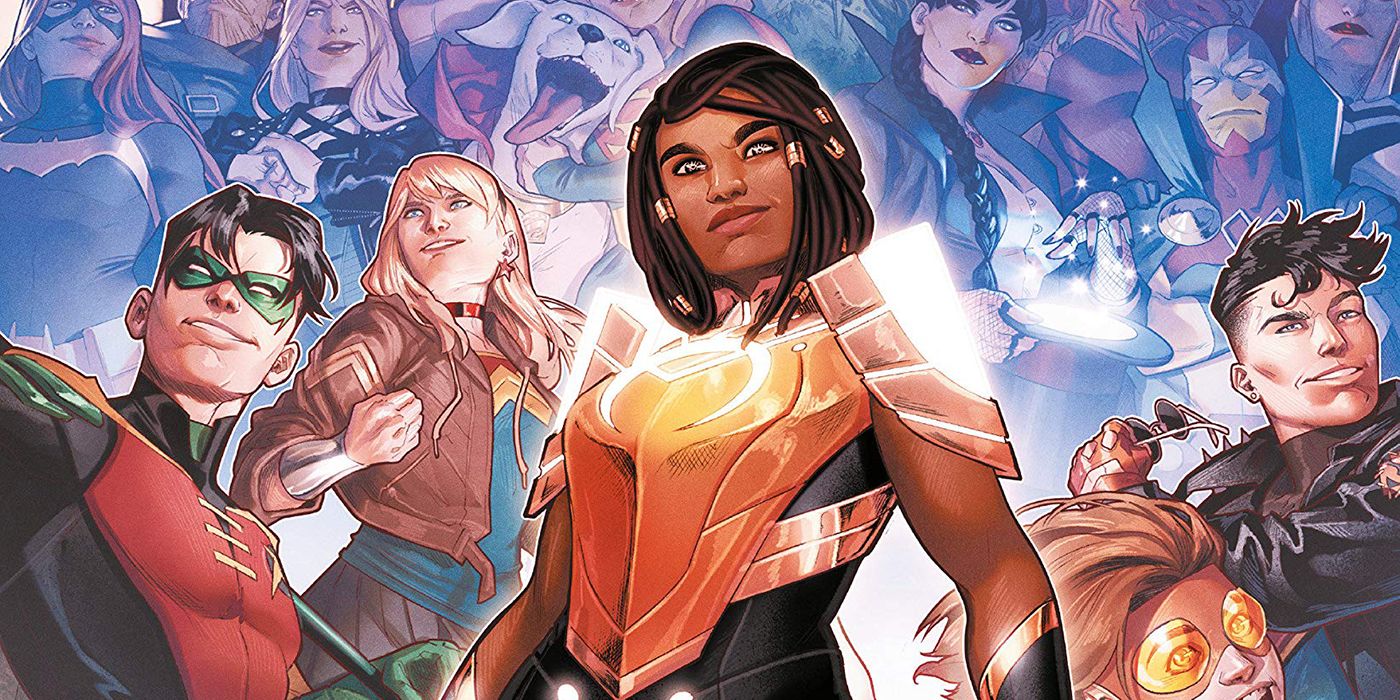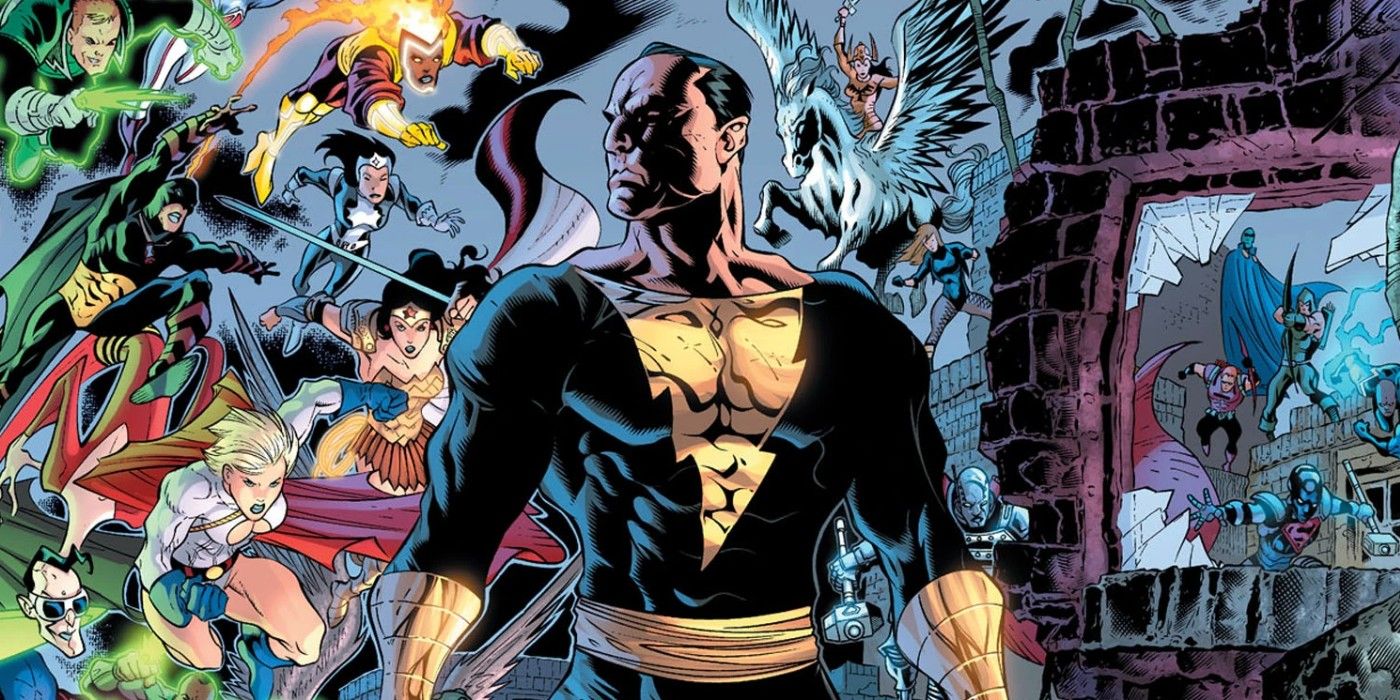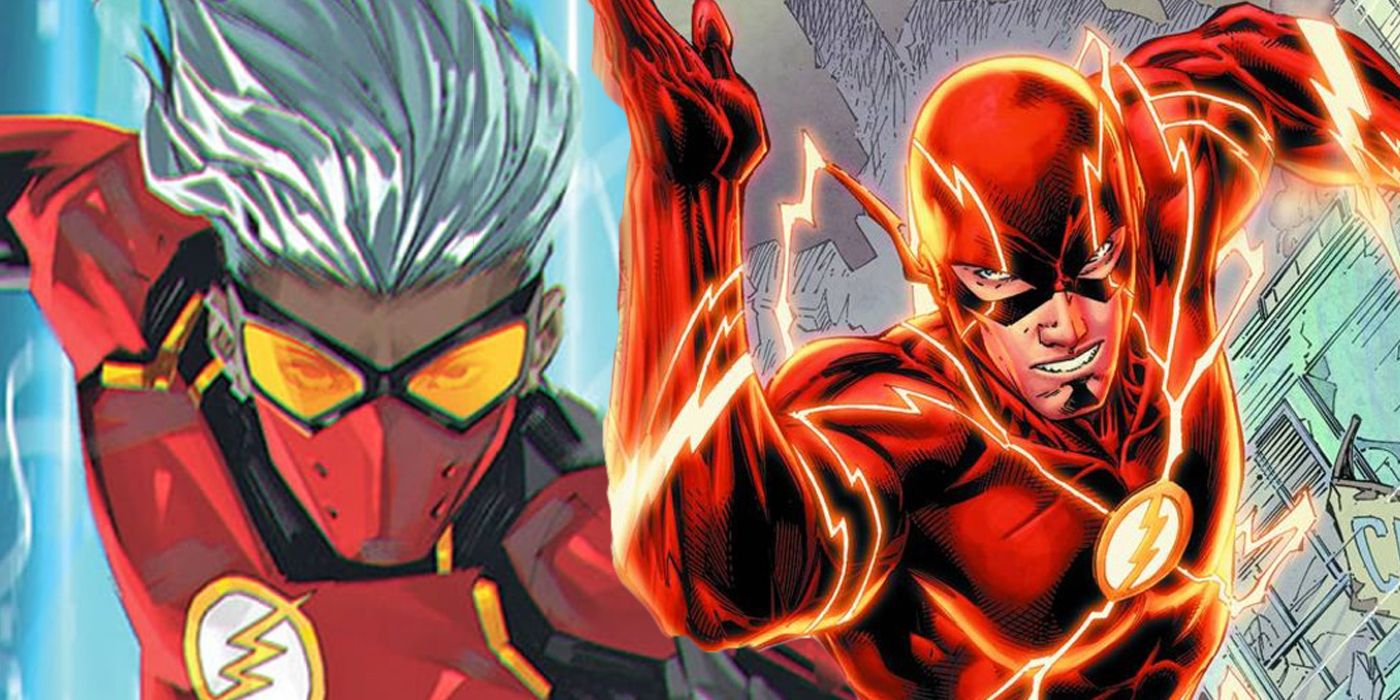There is a new era beginning in DC's Justice League comic, as the arrival of the new Infinite Frontier sees the company's biggest heroes placed into the hands of writer Brian Michael Bendis and artist David Marquez. And you don't assemble talent like that to play things safe.
Screen Rant was fortunate enough to take part in a roundtable interview with Bendis (Superman) and Marquez (Batman/Superman) about the launch of their run. Whether fans want to know about the new roster assembled, the mysterious villain threatening the team, or what real-world conversations, crises, and controversies are informing their work, nothing was off-limits. Readers can find the full interview below, before the story begins in Justice League #59 on March 16th.
What's the most challenging part of creating a Justice League lineup?
Brian Michael Bendis: It wasn't challenging, so much as one of the funnest parts. Probably, the challenging part is that, when I was given the Avengers or Guardians, part of the excitement was I didn't know what I didn't know. But once you've accomplished that, you now know what you didn't know.
Going into the Justice League, I can't claim ignorance. I've learned all the lessons. But what's cool is you basically learn what's the most interesting lineup of characters for this moment in time in the DC Universe. It really isn't like, "Who are the most epic, the biggest, the most powerful?" It really is about who are the most interesting, not only separately, but together? It's the story of this character in the moment that they can share with their fellow teammates and partners.
That got very exciting, and that changes the dynamic. There were certain characters that I already had a toehold in, like Superman, and with that came some other developments. Because of working on the event Leviathan and then Checkmate, I had very strong feelings about Green Arrow and what he would be doing on the team.
The one DC came to me about was Black Adam. They were like, "Hey, is that someone you think you've got a feeling for?" Because that's a character that's obviously going to be grabbing headlines in a year two. And I did; I really liked that idea. It immediately challenged me and made me think back to what we were doing with Dr. Doom in Iron Man. He is a very different character than Victor Von Doom, and I wanted to see what we could do in that regard, and how his appearance really challenges the idea of the Justice League and these teammates that have known each other for a very long time. Some of them are ride or die teammates, and then here comes this person that does really challenge everything around them. So, that got very exciting.
From there, it really was building and building and building, and then someone brought up Naomi - it honestly wasn't me. And for the same reasons as Black Adam, I got very into that. I called David Walker and said, "We have some opportunity here to do something new with your hero's journey that we weren't even going to do." That's pretty exciting as well.
Everybody came in with a unique perspective, like, Aquaman's in a unique place in his storyline. All of those elements really came to bear. One that I got excited about and had to do the most research for was Hawkgirl. But the characters' stories are so rich, and they bring so much to the table, that I just go, "Here's a very unique lineup. I would totally buy this book." And that was it. That's how you know. We David did the first cover sketches, I'm like, "I would buy this book in a heartbeat. It's gorgeous." That's a long answer, sorry.
David Marquez: Yeah. Really, really briefly. I think one of the challenges of coming up with the Justice League lineup is making sure that it feels like it's all the heavy hitters and A-listers without necessarily repeating what's come before. There's a balancing act between making sure it's recognizable as the Justice League, making sure that you have characters that are representative of what we all recognize as being the Justice League, while also keeping it kind of like new and fresh. And that's where a lot of new characters come in.
When Brian first pitched Justice League to me as a book for us to go into DC together with, I think the way he phrased it was, "We want this to be who are the coolest characters today?" Part of that is not just who are they individually, but as Brian was saying, this is a team book where how they bounce off each other is everything. Having that contrast between characters with different points of view and that represent different parts of the DCU are all important considerations that we talked a lot about from the very beginning.
Will tackling this particular team dynamic change the way you write and think about Superman, even after so much time with that character?
Brian Michael Bendis: A little bit. But I'll tell you, I involved the Justice League very quickly into the dynamic of his life change. The third page was them reacting to what happened, or an enormous part of that. But what I get now, the gifts that I get, is that I get to take what we did to the Superman mythos and immediately apply it to the group dynamic as it evolves.
Philip is doing amazing things in Superman in concert with us, following along with the choices we had made, and now we get to see Green Arrow and everybody react to him differently than they have in the past. They have to deal with this, and it changed the dynamic of everything in his life. Mostly for the good, some for the awkward, and some for the bad. And they're still dealing with it. Literally, the first couple of sentences in the book is how, by Superman doing what he did, everything has changed for the Justice League and everything around us. It just has, so let's not pretend it hasn't. Let's deal with it. And that's part of the theme going into the book.
The fun thing about team books is playing with different character combinations. Are there any character pairings you're looking forward to writing or drawing?
Brian Michael Bendis: Yeah, it's already happened. Black Canary and Hawkgirl are they the coolest. And I might say, the cartoon and other creative teams have set the table for us beautifully. This feels very similar to things that happened with other team books that we've been on. But every once in a while you're like, "Oh, this table is set. We can just have fun." These characters really like each other and admire each other, and are being challenged at the moment. We have found it just makes for the best dynamic. The friendship is there, but everything around them is on fire. Let's go.
David Marquez: Yeah, there's the classic combination, for me, of Green Arrow and Black Canary. There's a ton of them to draw. With Batman Superman, which I was working on before with Josh Williamson, I had a lot of opportunities to work with those characters. I'm pretty comfortable drawing them, so for me, a lot of it is about stuff I haven't gotten to draw before. Black Adam has been a complete learning curve for me; the way he interacts and the way he contrasts with Superman is really interesting.
One combination that Brian has had a lot of fun with, clearly, in the scripts is Batman and Naomi. In the issue I just finished drawing, there's a whole sequence of them two together. The way they bounce off each other is a lot of fun that way, I'll put it that way.
One of the joys of working on a team book is when you have breakaway moments with either groups or pairs of characters. We have a pretty large cast even for a team book, and already just a few issues in, I find myself constantly having these new combinations and new contrasts to draw. And every issue has a new one to play with, so there's a lot of opportunities for that as an artist, as a writer, and also for the audience to enjoy.
Brian Michael Bendis: That's a good one about Batman and Naomi, because Naomi is as raw a character that that this team has ever had Batman historically has an apprenticeship mindset, so he immediately starts lecturing and tutoring whether he's been asked to or not.
The two of you have worked together on numerous successful projects. Can you describe your working relationship?
Brian Michael Bendis: Successful.
No, honestly, we met early on in his Marvel career. I think Phoebe showed your work to me, and I was like, "Oh yeah. This guy's really good." I always have an eye out for people who are ready for the stage and whatnot, and are right there. Right at the cusp and could go either way. David, much like Sarah before him, was absolutely that.
Also, what happens is you see people's work and it just speaks to you. We've all experienced that; you just look at someone, and there's something about their line weight that just makes you go, "I like this person." We started working together on Miles, and immediately that first page felt like, "Oh, man. Yeah, this is working." We challenge each other in the best way, we inspire each other in the best way. There hasn't been a page I haven't felt that way on.
It's lovely, where you can have a creative inspiration that's a little out there and know that you can bring into the table without derailing everything. If I come to David and go, "We'll draw this like a different cinematographer would or something," David won't go, "Ughhhh." He'll go, "Yeah, sure." He'll love the challenge. What I've attempted to do ever since I met him is try to write towards what I see very clearly as his unique voice, and not to like waste one page of it. To make sure that the emotional truth of the page is there for him to draw, because that's what he wants to draw.
If there's a challenge, that's the challenge: to make sure you're, you're living up to it. Also, I know know what he thinks is fun to draw and what isn't. I know sometimes, just as a friend, I want to give him a gift of fun stuff to draw. Because I know how important his drawing time is to him, and I want him to be enjoying it. So, it's all that.
And may I say what I've loved so far is every opportunity we've had has been very different from the one before it. This is basically us following Defenders, and this couldn't be any more different. That makes me very happy that we're capable of such different things. And on top of this, we've also been quietly working on a creator-owned book together underneath this. There's a lot of emotion going into the work just because of that, too. There's like an underlying theme, at least for me.
David Marquez: I like you alright.
No, hopefully it comes across. Brian's talking about this, but we're good friends - to the point where, shortly after we began working together at Marvel, I moved to Portland to work more closely together and see each other in person. We became very close friends and our families are close friends, so we always have an ongoing conversation, whether it's work related or we're just chatting on our own. We have a very easy rapport that I think comes across when our work gels so well together.
I think it did that initially, without us talking to his friends, but it's only become better over time. But specifically, and I think I've talked about this a lot in the past, what we both really enjoy doing in our work - and I think that helps our work gel so well - is working on the character moments. Brian talks about what's the emotional truth on the page, and that comes across with the characters. I love emotional moments with characters where, hopefully on the page, the reader can get into their mindset and feel what they're feeling. Brian's writing is just chockfull of that material, and I try as hard as I can to bring that through in the art.
And like Brian says, we each have the things that we do naturally on the page, and there are areas where he tries to challenge me and push me in directions I maybe won't go automatically. And there are also places where he'll write a story or a scene in a certain way, and I'll want to take a different direction from the way it was written. It's this give and take that we both feel very comfortable with each other doing, which isn't always the case with a creative partnership; you're afraid you're stepping on the other person if you change it too much.
But for us, when we have the same idea about something, it works really fluidly. When we have different ideas about something, it ends up stretching and helping each of us help the story grow into something that it wouldn't otherwise be and that isn't possible in every partnership. So, this is a really cool opportunity to get to do that.
So, David is officially the newest member of the Portland Mafia?
Brian Michael Bendis: He's been here for years. He was an original OG and moved back to Texas. But he was here for a long time. David was here during some really powerful moments in my life, and it was amazing.
Brian, I'm sure you've seen the rumors online about DC renaming Black Adam Shazam. Can you clarify whether that's actually the case? And more broadly, can you talk about Adam's arc, and how this series builds helps him become a more heroic and benevolent leader?
Brian Michael Bendis: Alright, just so we're very, very clear. At no time ever in the history of the planning of this book - in any format, in any stage, or in any way - has the production ever been about Black Adam changing his name, his legacy, his anything. His name is black Adam, but someone else calls him something in the book.
It's like someone putting out a headline saying that Marvel changed Spider-Man's name to Web-Headed Menace because somebody called him that. No, that's why I didn't respond to it. It's just so ridiculous. Even responding to it now is helping a click machine I'm not interested in.
But that said, I will say we're very excited about Black Adam's storyline here, because it is unique. It is unique to the character; it is unique to the story, but I think celebrates it in a very surprising way. I must say, we will be forever grateful to the Rock for stepping out with this before us, because we didn't know that was coming. We actually didn't realize that, but it certainly makes people look at what we're doing with a curious eyebrow. It's like, "Alright, listen. Let's see what you can do."
His character has been around for a very long time - Superman actually says this in the script. He's been around for a very long time, and with that comes shifting perspectives. Things change, and even in our short lifetime, David and I have realized you live long enough to see things differently than you did a few years ago. The world has changed a lot. so Black Adam is responding to that, and already has been. We're going to see exactly what that means, and if there's a place for him on the Justice League at this time, after all has that has been said and done in the past.
David Marquez: As someone who gets to read this comic before anyone else does, it's interesting seeing the ways in which it sometimes preempts conversations that we're having in the world, generally. We're not really making any concrete or authorial statements about the world and what should or shouldn't be. But it's interesting considering the perspective of somebody who has done so much bad stuff, and then questioning whether or not that should be the only thing they're judged for. It's a very relevant thing right now, and it's worth thinking about.
There's a Green Lantern symbol on that first page, but we don't actually see a Lantern in the issue. Will a Green Lantern be part of the group this time around? If not, was there a specific reason why?
David Marquez: I'll speak to it a little bit. Brian may have a more nuanced or a stronger statement to make about it, but the short version is that when we were talking about the initial lineup, there were some characters that had stuff going on and it wouldn't make a ton of sense for for them to be on Earth doing what we're doing on Earth.
That was part of the initial conversation. There may have been more to it than just that, but that was the part that I remember. Who can we actually use, and based on what their stories are doing with them right now, would it make sense that they're part of what's going on here? And in this case, no.
Brian Michael Bendis: There is a Green Lantern focused story coming very soon. And I I'm going to pause my answer at this point, because I legitimately don't know what's a spoiler at this point. But there's big goings-on in the Green Lantern world, and we will as a book that focuses on the major legends, be absolutely a part of that.
Honestly, the only bad part of doing things like this is that almost every character in this book is being shared in another story. And I'm desperate not to accidentally spoil someone else's very hard work, and some of these people have been working their asses off through pandemic to deliver the goods, and I want to make sure that everyone gets to surprise you the way they want to.
Are there any particular characters that you are looking forward to writing and drawing?
Brian Michael Bendis: Well, if you're talking about the main cast, then all of them. It's literally the final checklist on the pro-con list of if they should be on a team: do you want to hang out with him all day? If the answer is hell yes, then yeah, that's the answer. Yes to everyone on the team, individually and in all the different group dynamics that we've been able to do so far.
Also, because it's the Justice League, and it's the Hall of Justice, we're going to have an opportunity for a lot of guest stars and guest spots. David is probably shocked to find out The Flash has appeared in every single issue so far, to the point where I'm not sure why he's not on the cover at this point. And there are other guest stars coming.
We have this great new format, where our backup story is Justice League Dark, and Justice League Dark actually takes place in the same building sometimes us. So, not only are we sharing our book, but we're sharing almost a location - which to me just opens up all kinds of interesting possibilities. Immediately, I called Jamie and Ram and said, "Hey, let's mess with all the pages." Let's make it a giant Justice League graphic novel, and use the eight pages in the middle of a story. It's all mixed up together in unique ways.
So, after the story we're telling right now, we're going to dive into a very big magic-themed story that's a basically a Justice League Dark team-up story. But the format of the book allows us a very unique way to tell the story.
David Marquez: Yeah. It's always tempting to say, as an artist, "It's a team book, I love drawing everyone," and that's absolutely true. But one of the cool things with this lineup that we have is I got to do a little bit of design work. Hippolyta, who as readers read the first opening art, you'll see the way in which she rolls into the story. I got to do a new design for her, and there's always a funny dynamic as an artist coming up with a design. What's fun to design doesn't always play into how fun it is to draw on every single page. I was mindful and attentive to those considerations when coming up with her design, and I'm hoping that it plays out the way I expect.
But also, the new villain that we have for this opening arc was another new design of mine. Funny thing: I haven't drawn a character with horns in a while. I wanted to draw a character with horns, and then Zack Snyder came out and gave us lots of horns. That was an unintentional synergy, which isn't quite the word...
Brian Michael Bendis: A top of the hat. A honk of the horn.
David Marquez: There we go, yeah. It's always fun to get to draw your own designs on the page. I also got to do a slight update to Black Canary that I'm really enjoying. I can't tell whether it's 5 or 500 or 5000, but there are some very enthusiastic Black Canary fans online, and they've let me know that they approve. It seems, so far. These are all fun things.
Was there any character that felt particularly daunting to tackle?
Brian Michael Bendis: Well, I think the more challenging storylines, like Black Adam introducing an idea that is counterintuitive to half the team and half the audience - really, maybe even more than half the audience. You know that's like you're throwing down the gauntlet, like here's something we're challenging you with. Not only that, but it already has been set up that his relationship was fractured. We're coming into recent storylines that made this a challenging idea, but not one to run away from; one where you go, "Let's make sure we're being honest on every page. Because if we're not, it's going to just reek. It's just going to sink."
I tend to get a little parentally shy about Naomi. But what we're bringing a lot here - because I was one of her co-creators, and with that came this world that we co-created for her that really is in some ways a bigger deal to us than this Naomi herself. It's this universe that came with her, and from our very first issue, we're opening up a very big door into what the universe is. So, people who read the original Naomi miniseries will be like, "Okay, we're going to write in."
And then for people who haven't read the Naomi series, we're about to introduce something to you that no one's seen before. And that's very daunting. It's a new Earth that's been established to have been devastated by a superhero battle that no one recovered from, that killed Naomi's parents, and that devastated this land. We know as comic creators, that opens up all kinds of possibilities for us: designing, and also to surprise and delight people who think they've seen every kind of apocalyptic scenario. This is a very different one, and to design and write into that is hugely challenging. It is a big challenge, but I think that's why people read comics. So, that's our job.
David Marquez: For my part, there are two big challenges that are always a bit daunting. I really like working on stories where I get to build up the look and feel of the world myself. I've done a lot of work where I jump in midstream on a book that's already going, and I inherit a lot of what's immediately already there, and then I have to take that ship and keep going with it.
And while there's been clearly decades of Justice League comics before, this is a chance where I get to hopefully take something that is recognizable and iconic and has a long history to it, but put my own spin from page one and make a strong statement with that. There's a lot of responsibility, and it's a big challenge to not to drop the ball.
Then more specifically, Black Adam is a character that I've been familiar with for a long time, but I can't say I spent a lot of time with him. It's familiarizing myself with him, with his history, and with his story - as well as trying to figure out a way of representing him appropriately on the page. Because he's not just a cackling villain. The most interesting characters - especially ones that are villains or have villainous backgrounds - are made relatable. The simplest way of describing it is the best bad guys don't do themselves the bad guys.
So, I'm trying to bring across that degree of complexity to the character, in the way that they emote, the way they treat other characters, the way he's sneers. I don't want him to be off-putting as a character; he's one of the protagonists now in our story, which doesn't mean he's always going to be making good decisions or making the decisions we would agree with, or the rest of the team would agree with. But I wanted him to be relatable and hopefully likable or understandable, but relatable is a big part of it. And also, I wanted him to look cool. Learning my way around him has been a challenge, but it's been a lot of fun.
Brian Michael Bendis: The other thing too is these are all very intelligent characters; very intelligent in different kinds of ways, and that's an interesting thing to write. That kind of crept up on me. There's no goofballs on the team; Green Arrow is the biggest goofball right.
With Naomi and her backstory playing a large role in the series, what does that mean for the future of her solo series?
Brian Michael Bendis: It hopefully impacts it in a very positive way. This is all being planned with David Walker in concert, and the idea really was that Naomi is going to return to her world rattled by what's happened to her so far, not only with Justice League and Young Justice, but some stuff that happens in Action comics. She's gotten a pretty intense view of the DC Universe quickly.
I harken it back to when a musician gets a hit really quick; they write a hit song and then all of a sudden, three weeks later, they're on the radio and it just kind of happens. This is what is happening to her, and then returning to the second series as a young woman dealing with all of that; all of the responsibility that's been forced upon her, in a way that I think is very different and unique to what we've seen before. That's what got me and David very excited. So, it's still coming.
Honestly, it's one of those things [that's] just opened up these possibilities, and it's just been cool that all the pieces have been in play in a way that allows us to play around with the hero's journey a little bit in a way we may not have yet. It excites us really, as writers and storytellers.
Besides Hippolyta, are there any heroes and villains that you're looking forward to redesigning?
David Marquez: If they were to give me the keys to the kingdom, man, I would have a fun time. But for this book, one thing that Brian and I have talked about is not only creating some characters to play with, like we did with the villain, but there's also a vault of sketches I'm working on. Brian likes asking artists, "Open up your sketchbook and give me stuff to play with." We've already played with that idea a little bit, and perhaps down the line, we'll work some of them in.
But also, there's the idea that the cast for Justice League can be a rotating cast to some degree. Maybe there's a core where you take in or take out people on the periphery, or maybe in some cases, you take out the core, and it's just the characters that you would think as just peripheral. But because of the needs of the story, they end up becoming the centerpiece of the plot. We've talked about how down the line we want to play with who the lineup is, and we may bring in characters that aren't currently in the lineup as we've seen it. So, there I'm hoping there's some opportunities for redesign, even with some of the current cast members or characters we've talked about [redesigning] them from the outset or down the line.
I'm not going to mess with Superman and the trunks, right? I'm not going to do that. I'm not going to take Batman's ears off. Or am I? I know I'm not directly answering the question, but there's a lot of opportunity to play with design. I've already done it, like I said, for Hippolyta. A subtle one to Black Canary, just because I think her look generally speaking is pretty iconic. And I think there's ways of putting a little bit of spin on it that doesn't get rid of what we think of as being her silhouette or or her general shape. I do tweaks here and there with all the characters, even with Superman's belt or the shape of the bat on Batman's chest. I play with these things a little bit here and there.
In terms of bigger redesigns, though? Down the line, we're talking about opportunities for that.
Brian Michael Bendis: And there's going to be things happening in the other titles, like the Superman and Batman titles, that will allow you opportunities that are pretty cool, and we will reflect that.
With Dark Nights: Death Metal bringing all past DC continuity back into play, do you find yourself having to rethink how you approach characters you've already written in the past?
Brian Michael Bendis: No. Honestly, I think what they did was they really got it back to how it's just about the truth of the character in the moment. I mean, that really is what they were saying: that all those moments matter to somebody when they read them. And by putting that back, it just all matters. Anything you felt about those characters, that feeling is legitimate. That's what it meant to me.
So, we're writing the characters in a moment - hopefully, in a very powerful and significant moment in their lives - so it's all about how the past got them to this moment. I think we're reflecting that across the board. It's one of my favorite things to do, really. Write, "Who is this character? Why now, and what's standing in their way?" That's how we write Batman; that's how we write Superman. Even with this enormous legacy, it's really about the moment that they're in and making sure that their character is reflected well in that moment. That's a good question, though. I think about it a lot.
David, one of the things I love about your Superman is how effortlessly powerful he is. He's not incredibly bulky or muscle bound, either. There's a nonchalant, badassness to the character. Is that how you approach him, or is there something else that inspires your take on?
David Marquez: First of all, thank you. That's a huge compliment, I appreciate it. He's one of the characters I put the least deliberate thought into, in terms of the way that I draw him. When I wanted to draw Superman, the first drawing I did of him felt right coming out of my hand.
More than anything else for me with Superman is I want him to be kind. Maybe that isn't something that has a very tangible presence when you say it, but he's powerful and he's strong. I don't know if I think of him as being paternalistic, although I think that's not an inappropriate description of him. He's the friendly neighbor everyone feels comfortable and safe with, or a teacher perhaps. He's a role model that people look up to, but also identify with to some degree.
But when I feel like I nail him best, when I'm drawing on the page, is when he's looking upon the world and the characters with affection and with love and with caring. And everything else is secondary to that. No one can hold a candle up to him, in terms power level. He could destroy everybody, but it's nothing that would even cross his mind. All he wants to do is take care of people. That's always what's foremost in my mind when I'm drawing him.
Brian Michael Bendis: I gotta say, even the stuff you were doing Joshua, I thought, "Oh, my God, does he loves drawing Superman and love drawing Batman. And they come across in their facial expressions, but in a good way, where it looks like Batman loves being Batman and Superman loves being Superman." Not in an ego way, just that you get very comfortable and are enjoying the partnership. I took that with us to Justice League, and I really wrote this whole thing down about, "This is probably where Superman is the most comfortable in his skin. Not in the Fortress of Solitude, not at the Daily Planet, but right here with his friends that have literally been there and seen it and done it all."
He loves the challenge, and I just find him to be a joyful presence on the team. I don't have to write him going, "Wow, I'm having such a good day." It's just always on his face. I tend to write him up just a tad sillier, because he's just having so much fun talking to friends about being a hero.
It's got to be challenging to create a new villain in any capacity, especially one who has to be powerful enough to give the League a run for their money. Brutus definitely does that in his debut, but is there something you avoided in regards to his character or design to keep him from feeling like so many villains in the past?
David Marquez: I looked at a lot of the recent character designs for characters that came out over the over the past 5 or 10 years. ...I tried as hard as I can to lean away from all my first instincts for drawing the character, and the thing that it came down to was the horns. It's a weird thing to latch on to, but the shortest answer is I wanted to make sure he didn't reflect a lot of the other characters we've seen recently. Like I said, Zack Snyder's Steppenwolf has massive horns - but different horns. My guy has different horns.
Another fun thing is, actually, his design shifts slowly throughout the opening arc. I'm purposefully making his design not like his costume. Hopefully, it's his posture, his movements, his attitude, and my unique horns.
Brian Michael Bendis: For me, this is another Introduction to what happened in Naomi's world. Not only are we debuting a new character, we're unveiling a lot of things about a new playground for the Justice League to have to deal with. And [it was] that his voice not be too "Muahahaha" or too irreverent. That's another thing that I think I've had enough of: the Vince Vaughn of villains. He has a very specific goal and very specific agenda, and you can absolutely see why he wants what he wants, why now - all of it is very, very clear.
Is there anyone outside of the expected norm that you would personally like to see on this team?
David Marquez: I can't give that away for free.
Brian Michael Bendis: Yeah, I can't give it away. But yeah, absolutely. 100%. I will say, in that regard, we have a couple of storylines coming up that actually pivot from stuff we set up at the end of my Superman run. Some new characters and new ideas, with the opening of the United Planets having their own Justice League that we introduced on my last issue of Superman. They're going to come into play, which brings a whole new lot of characters coming to the table that feel very entrenched in the DC mythos, and that I think are going to be hopefully very exciting to some people.
Brian, you've mentioned before that your story and Justice League Dark will ultimately intersect. What can you tell us about working with that creative team on bringing the two stories together, and what can you possibly tease about that story?
Brian Michael Bendis: I can tell us about that story that it also will hearken to something that we set up on my last year of Superman. There's a new Lord of Chaos that's been buried away for many, many years that Superman and Dr. Faith were just able to defeat by the skin of their teeth. She's going to come back huge as an enormous challenge to to both the Justice League and Justice League Dark.
We're very early goings in the collaboration with the Justice League Dark team, but I will tell you that I threw this nonsense at Ram. He could have easily said, "Hey, dude, can I just leave it alone?" And instead it was like, "Yes, that sounds awesome!" When people come back to you with that kind of positive energy, of always seeing the story potential and always seeing the format potential of it, I just get very excited. Right now, we're in the early stages of everyone agreeing. So, we're gonna have fun with it.
And also, I think David's going to have a lot of fun drawing the Justice League Dark characters. I know that even from the cameo they had in Superman with Kevin Maguire. Everything about them is personality, personality, personality. So, it's a lot of fun to draw.
Whose idea was it to include Black Adam on this team?
Brian Michael Bendis: This came to me editorially; it might have been Jim Lee's idea. In fact, I believe Jim didn't come to me directly with it, but they said, "Jim wants to know if you like this idea," and I said yes. It was that simple, and it was a while ago too. It was very early on. I knew that I was taking over Justice League for a very long time, so it's given me the opportunity to plan and coordinate and even set up things in my Superman run that I knew I could build upon. I noticed that some readers were going, "Wow, you're dropping a lot of new villains in the last three issues of your Superman run." It was because I knew I was going to have them to play with in Justice League.
David Marquez: Yeah. Even from the very first conversation Brian and I had about me coming on to draw Justice League, Black Adam was one of the first things out of his mouth about it.
Brian Michael Bendis: It seemed like that alone was unique Justice League. That story in itself, and - if I could be egotistical a little bit - I've got some runs under my belt. Even things that people at the time were mad at me about, now they're happy about. Knowing what I know now about writing Avengers and Guardians of the Galaxy and X-Men, I wanted to bring all of that to the Justice League as almost a learned lessons and apply them directly to these very first pages.
Black Adam and Naomi, those really added elements to the whole thing. And I just really wanted to write the classic Justice League in a way too, so it's having both things at once that made me very excited.
David Marquez: Getting to be the first reader of the book, I took some convincing to really get behind the idea of Black Adam being on the team. But at this point, I don't know how else we would be doing this book. It feels natural him.
And, the contrast between him and Naomi on the team is something that's very, very new and fresh and different than what I've seen in the book in the past. For me, what they bring to the team is the heart of the book.
Brian Michael Bendis: Let's make it clear, most of the team is not on board with this. It's Superman's idea, so they like, "Ugh, Superman, challenging us with his goodness." They're not on board, so it is discussed. It is an ongoing concern.
In Infinite Frontier #0, Barry Allen joins Justice Incarnate. Yet he appears in Justice League to hand over the mantle to Wally. Who will be your Justice League's official Flash, Wally West or Barry Allen?
Brian Michael Bendis: Barry is in our book as a guest star. And again, I laugh because he's guest-starred in every issue. Eventually, if I was his agent, I would be calling going, "Bump him up to regular! He's in every episode." But yeah, it's Barry... For a reason.
That pause is me going, "And anything else I say is a spoiler in someone else's story, so I'm going to shut up."
Balancing multiple characters is never easy, but are there any Justice League runs that you feel got it right?
Brian Michael Bendis: Yeah, I'm a huge fan of the book, and I have stated very loudly for many years that Justice League #200 may be the perfect superhero comic. There's like 10 perfect superhero comics, and that's one of them.
Justice League is also great about allowing mini team-ups within the team. They always did that, which I always like. Brad Meltzer's Justice League is one I really, really aspired to. I don't want to leave anybody out, but I gotta say the Justice League cartoon has been an enormous influence on what I think is the energy of our run. It's what I'm reaching towards, because I thought sometimes the cartoons are really excellent at just distilling the characters down to their basic character, but still always reflecting an enormous legacy. You always feel like there's an enormous legacy behind each character. I know they were using the comics as their base, but I thought they took it to a level, and I'd like to stand on their shoulders and try to take it to another level.
David Marquez: Yeah, I think Brian's comment about the cartoon is excellent. I think the best of the cartoons, what they do so well is they distill the mythology and the characters down to their essence, and that then gets put out into the world. While we have a lot of comic readers, it's nothing compared to what the cartoons or the movies and TV shows have. There are generations of kids for whom - like, for me, Batman: The Animated Series was the definitive Batman. And I think for a lot of readers who are now adults, it was the Justice League cartoons.
In terms of the comics and stuff, I'm going to leave people out of it, because there's no way of remembering every single example of it. But I was getting back into comics when Grant Morrison was writing it, so that has a special place in my heart. It's clearly different than the kind of stuff we're doing, but I like what he brought to it. Also, this is a weird one that's off to the side, but I really, really loved Alan Davis' Justice League: The Nail.
Brian Michael Bendis: The Nail is fantastic. I love that. That's a great one.
David Marquez: It's Elseworlds, it's weird, but thematically what it does is similar to what we're doing. It's, "What is the core point of the Justice League? What makes the Justice League the Justice League?" One thing we haven't talked about at all during the interview, but which was really important as we were conceptualizing the series, was the idea of "Justice for whom?" That was the core conversation and mission statement for us for the first two or three months we were talking about doing this book.
The word absolutely means something. Similar to the way I approach Superman, and the way Brian does as well, of there being this seed of goodness at the core of him that defines him - I think, similarly, there's got to be a seed in the core of something within the Justice League. And to a certain degree, Superman does represent that. I'm not saying you can't have a Justice League without him, but his impact and his influence on the team is very definitive. And I think that's one thing we push really hard in the book.
Brian Michael Bendis: Good Lord, I almost forgot Justice League International. The Keith Giffen, J.M. DeMatteis and Kevin Maguire run on Justice League is why we're here. Both of us are actually dear friends with Kevin and relish that. I think it's one of those books that changed all of comics for the better. In rereading it at the beginning of the pandemic just to have it in my bloodstream while I was writing Justice League, I was amazed about how many turns it took tonally. Remember the funny stuff, like Guy Gardner getting punched in the face and all that? It kind of pivots to many sub-genres, and it made me excited to do that on our own terms. I think it's right over my shoulder, and it's an enormous influence.
David Marquez: And a big part of our conversation as we were conceptualizing the book as well. Totally.
Brian Michael Bendis: That book was endlessly fun, and the stakes were always high.
Is there anything either of you can tease about what is coming up in the series?
Brian Michael Bendis: This is gonna be a vague answer, but it's sincere. The great thing about doing a book like Justice League, and we had it with Avengers as well, is that it's a book where all the characters converge. It's a place where all the subgenres of superheroes come together in one building. That alone makes it, even unto the superhero genre, the place where magic and science and mythology all clash together and have lunch. And that allows completely unique storylines; the ones where Superman goes, "I can't handle this by myself, I have to get my friends." Those kinds of storylines need to be epic.
Each character themselves is ready to set up an enormous epic storyline - everyone. We haven't even talked about Aquaman and what's going on with him. But every character has a huge storyline, bringing with them that the Justice League is going to need help. Though we're starting with Naomi and Black Adam, we're going to be pivoting into these other places and corners of the Justice League. Which will allow a lot of guest stars, a lot of back and forth, and some surprises.
I think the biggest surprise that I can say here, without spoiling anything, is that Checkmate is coming. Checkmate is going to be part of our Justice League storyline; not part of this book, but connected to the book in a big, big way. And that's coming soon; people have been asking for it every day, and I'm so happy to say it's on schedule. Part of the delay was getting everything lined up so Checkmate could be part of this as well.
And that just shows you: here we are in the middle of this giant, epic battle of the gods storyline. But right underneath it is comes this huge magic epic, and this big spy thriller, and they're all Justice League. And that's kind of amazing for me, personally.
David Marquez: Yeah, I don't have that much to add. But like Brian said, one of the awesome things about a big team book like this is bringing in characters that represent different corners of the DCU. Each of them brings a lot with them, and their concern for their respective corners of the universe is something that plays a role in the decisions the team as a whole makes. We're gonna spend time in different places and see to what degree their respective casts get brought into it.
The initial arc focuses on a certain location, but there's going to be a lot of reaching out and grabbing things from throughout the DCU moving forward.
Brian Michael Bendis: And it's just a big ol' excuse for me to continue to write the Wonder Twins. That's what all of this really about.
You end up having the heroes themselves say diversity of perspective matters. How did you work that in?
Brian Michael Bendis: I find it's a conversation that almost everyone's having in every workplace, every family scenario - everyone's having a conversation. And it just seemed to me to be the most honest conversation they could be having amongst themselves. And I also wanted to do it, like, nothing happened. They just decided they needed to; they just felt it.
I think, for a lot of us, we know that feeling. That alone is a problem: feeling like you see things differently and would like to act accordingly. Then you go to your friends and talk about it, and see what can we do. These are larger than life characters, and you can do larger life things to make the world a better place. We have the benefit of not being the real world. It's the DC Universe. It's a fictitious city and fictitious world, so we can wrap our head around these ideas on a more global scale. And that, I think, is a good place to have this conversation sometimes.
David Marquez: The conversations that we had before I started drawing, as we're coming up with what our approach would be for the book, we grappled with a lot of heavy thoughts about the direction the story could go. But I think that the simplest thing is, we're never trying to be heavy-handed with trying to beat a reader over the head, like, "This is what we think, and this is what you should think too!"
I think that the simplest description of our approach it the book is: this is not a cynical book. This is a book about earnest belief in the possibility of a better world. This is the way that the Justice League is grappling with how to accomplish that. And it has to include everybody, because Justice League is not an American team. It's not even ultimately - maybe you could say it's an Earth team, but it's not really. Look at how many non-Earthers are on the team.
When you're solving problems: at which point is the problem solved? Do you draw the line here, do you draw the line there? Is it a mission that ultimately will never be ended, but is always requiring efforts at every minute, every step of the way, for everybody? And I don't think you can be cynical when you look at the world that way.
Justice League #59 will arrive in your local comic book shop and through digital retailers on March 16th, 2021.

